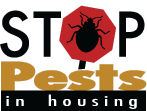- HOME
- » Frequently Asked Questions
- » How can you prevent reintroduction/reinfestation after renovating a unit?
How can you prevent reintroduction/reinfestation after renovating a unit?
Renovation is a great opportunity for property management to prevent pest introductions and infestations. Residents and staff should be taught how to prevent pest entry before the relocation or renovation occurs.
Pests show up in a new place by one of two ways:
- On their own, by crawling, jumping, or flying in. To prevent pests from getting in from the outside: install door sweeps on all exterior doors, make sure screens are intact, and seal any holes where pipes or wires enter a building or unit. Make the “building envelope” free of holes. See the "Maintenance Projects" suggestions on our Using IPM page.
- By hitchhiking in on people or their possessions.
- Ideally, residents will get their things pest-free before packing to move, but you may not have control over this.
- Have both staff and residents unpack items that come in boxes and recycle the cardboard and paper immediately. Mice, bed bugs, and cockroaches can get packed into boxes and insects will lay eggs on cardboard—get it out before the eggs hatch. Cardboard piles also make good homes for pests.
- Advise residents to look for pests as they unpack and have a vacuum handy to suck up any they see. Install monitors for cockroaches, mice, and bed bugs in the new unit to catch incoming pests. If bed bugs are a concern, wash and dry fabric items on high heat as soon as possible.
- Implement an inspection within the first 90 days of moving in. During this inspection continue to build a relationship with the resident; remind the resident about the IPM program; check the monitors; and address the beginnings of poor housekeeping practices, such as hoarding.
Before it is an issue, talk with your Pest Management Professional (PMP) about options for making incoming items pest-free. Always start with an inspection; never jump straight to using a pesticide. Control methods include heat (hot dryer, steam, or a container system), freezing, and fumigation. Your PMP should know what is available in your area. Preventative pesticide applications should be limited to special situations where the risk of pest infestation is high.
